
We are so used to pouring on the salt that it can seem daunting when we are advised to cut it out either completely or almost completely. I also don’t advise using a commercial salt substitutes like Lo-Salt or any other potassium chloride alternatives. They are unnecessary and potentially unhealthy chemicals that your body doesn’t require for optimal health.
If in doubt about eliminating salt from your diet, speak to your doctor.
For my part, I suggest that you simply do not ever get into the habit of adding salt to any meals. This is of particular importance if you have a history of heart disease or high blood pressure. Some of the populations with the lowest blood pressures in old age are those who have hardly any added salt in their diet. Remember that whole plant foods contain a natural amount of salt ideal for each individual plant.
It is so much better to get used to life without added salt and this is what I recommend to all my clients.
But if you have always piled on the salt (often before you even bother to taste the food first), how do you make meals tasty? And can you ever get used to life without added salt?

Your expectation of taste will adapt within days or a couple of weeks at the most, so that you start to appreciate and enjoy the natural flavours of different foods – whether plump tomatoes, crisp cabbage or a juicy mango. And we are talking exclusively here about whole plant foods – not animal foods or processed foods. To get an idea of this, have you ever changed your tea and coffee to having it with/without sugar or milk? You get used to it really quickly and then, if you try having it how you used to before, it tastes awful! Same to a large extent with salt.
Without salt, we start to savour the subtle and natural flavours of individual foods. But we can still benefit from the gloriously wide variety of flavours that can be added to recipes via spices and herbs. What’s more, spices and herbs are some of the healthiest and most potent sources of phytonutrients that humans can consume.
So let’s take a look at how you can spice up your meals and, at the same time, add benefit from some of the healthy compounds that herbs and spices contain.
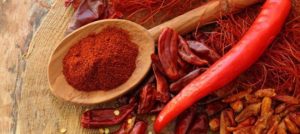
Blog Contents
Chilli
Capsaicin is the active hot ingredient.
Adding some heat (not too much, of course) can enhance many savoury meals.
Nutritional Yeast*
This is a really wonderful item to keep available. I buy it in bulk and use it a lot. You can buy it with or without B12 added fortification. If you are already taking a B12 supplement as recommended by your doctor or nutritionist, then go for the non-fortified version.
B12 fortification or B12 supplementation – see here.
Being rich in niacin, folic acid, zinc, selenium and thiamine, as well as containing a number of essential amino acids, nutritional yeast is a healthy option. It is also claimed by Dr Greger that it helps the body recover more quickly from strenuous exercise.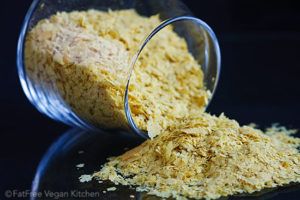
Nutritional yeast adds a deep “nutty” or “cheesy” flavour and it tends to find its way into most of the savoury meals I make. It is great in soups and stews, sprinkled on wholewheat pasta, baked potatoes, and the list goes on and on.
Best advice: get some and experiment.
*Avoid nutritional yeast if you have Crohn’s disease. If in doubt, speak to your doctor.
Non-Salt Spice Blends
Either commercially-available or home-made varieties are very useful and flavoursome.
 Experiment with commercial brands, if you prefer to have them made for you but try to ensure they really are salt-free. In particular, if they have onion or garlic powder added, check that it’s the powder and not some form of onion or garlic salt.
Experiment with commercial brands, if you prefer to have them made for you but try to ensure they really are salt-free. In particular, if they have onion or garlic powder added, check that it’s the powder and not some form of onion or garlic salt.
But if, like me, you enjoy being independent, knowing exactly what goes into your blends and also enjoy the process of making things, then have a go at making your own.
The following are two suggestions.
Standard Non-Salt Spice Blend
INGREDIENTS (play around with quantities to suit your personal taste)
- black pepper
- cayenne pepper
- cumin
- garlic powder
- lemon peel
- onion powder
- oregano
- paprika (I prefer smoked paprika)
- rubbed sage
METHOD
Just mix them together and put in either a grinder or a food processor. Store in an easy-to-use sealed container and add to meals whenever needed.
Dr Greger’s Savoury Spice Blend
This is one of my personal favourites. I tend to have a jar full of it in the larder ready to add to meals.
INGREDIENTS
- 2 tablespoons nutritional yeast (or yeast flakes)
- 1 tablespoon onion powder
- 1 tablespoon dried parsley
- tablespoon dried basil
- 2 teaspoons dried thyme
- 2 teaspoons garlic powder
- 2 teaspoons mustard powder
- 2 teaspoons paprika
- ½ teaspoon ground turmeric
- ½ teaspoon celery seeds
METHOD
Combine all the ingredients in a spice grinder or blender to mix well. Transfer to a shaker bottle or jar with a tight-fitting lid. Store in a cool, dry place.
(Greger, Michael. The How Not To Die Cookbook: Over 100 Recipes to Help Prevent and Reverse Disease. Pan Macmillan. Kindle Edition.)
I usually double the above quantities since I use it up so quickly. It is really moreish and, like everything Dr Greger suggests in his How Not To Die Cookbook, it contains 100% healthy ingredients – GREEN LIGHT FOODS.
Curry Blends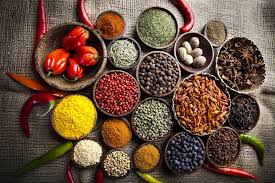
The usual garam masala spice blend is a good option:
- Black and white peppercorns
- Cloves
- Cinnamon or cassia bark
- Mace (part of nutmeg)
- Black and green cardamon
- Bay leaf
- Cumin
- Coriander
For a rich curry flavour, it is not a bad idea to have a go yourself at making curry blends. This is one blend that works well, but experiment and find what suits you best:
- 2 tbsp ground coriander
- 2 tbsp ground cumin
- 1 1/2 tbsp ground turmeric
- 2 tsp ground ginger
- 1 tsp dry mustard
- 1/2 tsp ground black pepper
- 1 tsp ground cinnamon
- 1/2 tsp ground cardamon
- 1/2 tsp cayenne pepper or ground chillies
Ginger
Ground or freshly minced/finely chopped can be added to give a flavourful kick to a recipe.
Coriander & other Herbs
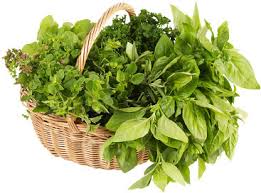 I tend to use a lot of fresh coriander in meals in place of fresh parsley, although both work well. It’s down to personal preference of course. Basil is a lovely flavour in the right place – tomato sauce-based vegetables on wholewheat pasta benefit from fresh basil. You can even make your own non-oil pesto sauce using it.
I tend to use a lot of fresh coriander in meals in place of fresh parsley, although both work well. It’s down to personal preference of course. Basil is a lovely flavour in the right place – tomato sauce-based vegetables on wholewheat pasta benefit from fresh basil. You can even make your own non-oil pesto sauce using it.
Non-Oil Lemon Pesto Sauce
If you don’t want lemon, then don’t add it and just have a non-oil pesto sauce.
INGREDIENTS
- 3 cups (80 g) fresh basil
- 1/2 cup (70 g) lightly toasted pine nuts
- 4 cloves of minced garlic
- 1 tbsp nutritional yeast
- 2 tbsp fresh lemon juice
- 1/2 tsp black pepper
- 3-4 tbsp water (more or less just to thin mixture)
METHOD
Place pine nuts into a pan on medium heat. Lightly toast them, they burn quickly so watch them carefully. Put all ingredients into a food processor and blend. Use immediately or freeze in ice cube trays. (To do this, place tablespoons into a tray. Freeze, and then remove from trays. Store in a freezer bag for later use.)
You can use pesto on wholegrain pizzas/pastas, in stuffed peppers, on lightly sauteed vegetables, or anything that takes your fancy.
Non-Salt Liquids
Pretty much all commercially-made soy sauces contain either a lot or some added salt. Again, I don’t recommend this. However, in terms of liquids that can be added to meals, it is possible to make your own umami sauces. Dr Greger explains how he uses it and what “umami” means: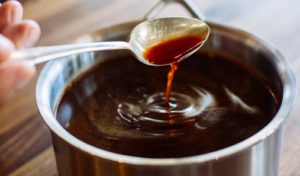
“Use this sauce in sautés or stir-fries to boost flavor without adding all the sodium of soy sauce. Umami is one of the five basic tastes, even though many people are only learning about it now. This word was created by a Japanese chemist named Kikunae Ikeda from umai, which means ‘delicious’, and mi, which means ‘taste’. The perfect name, as it is a delicious taste!” (Greger, Michael. The How Not To Die Cookbook: Over 100 Recipes to Help Prevent and Reverse Disease. Pan Macmillan. Kindle Edition.)
Here are two umami recipes:
Dr Greger’s Umami Sauce
INGREDIENTS
- 1 cup/ 250 ml vegetable broth (made from the water left over from boiling your favourite vegetables – just store it in a sealed container in the refrigerator for future use. See 1. below)
- 1 teaspoon minced garlic
- 1 teaspoon grated fresh ginger
- 1 tablespoon blackstrap molasses
- 1½ teaspoons date syrup (see 2. below) or date sugar
- ½ teaspoon tomato purée
- ½ teaspoon ground black pepper
- 1½ teaspoons white miso paste blended with 2 tablespoons water
- 2 teaspoons blended peeled lemon (see 3. below)
- 1 tablespoon rice vinegar
METHOD
Heat the broth in a small saucepan over medium heat. Add the garlic and ginger and simmer for 3 minutes. Stir in the molasses, date syrup, tomato purée and black pepper and bring just to a boil. Reduce the heat to low and simmer for 1 minute. Remove from the heat, and then stir in the miso mixture, blended lemon and rice vinegar. Taste and adjust the seasonings, if needed. Allow the sauce to cool before transferring to a jar or bottle with a tight-fitting lid or pour the sauce into an ice cube tray.
2. DATE SYRUP
1 cup/ 175 g pitted dates 1 cup/ 250 ml boiling water 1 teaspoon blended peeled lemon (see 2. below). Combine the dates and hot water in a heatproof bowl and set aside for 1 hour to soften the dates. Transfer the dates and water to a high-speed blender. Add the lemon and blend until smooth. Transfer to a glass jar or other airtight container with a tight-fitting lid. Store the syrup in the refrigerator for up to 2 to 3 weeks.
3. BLENDED PEELED LEMON
Instead of cooking with lemon or lime juice, use the blended whole fruit to get more nutritional benefit. Peel and blend a whole lemon and then freeze it in 1-teaspoon portions – a small silicone ice cube tray is ideal for this. Then, grab a cube from the freezer whenever you need it!
(Greger, Michael. The How Not To Die Cookbook: Over 100 Recipes to Help Prevent and Reverse Disease. Pan Macmillan. Kindle Edition.)
Simplified Umami Sauce
INGREDIENTS
- 1 cup/250 ml water
- 1 tablespoon cooked rice vinegar
- 1 teaspoon molasses
- ½ teaspoon dark brown sugar
- ½ teaspoon garlic powder
METHOD
Mix all ingredients together and enjoy. Will refrigerate for 1 month or freeze in cubes like Dr Greger suggests.
It’s The Food!
Advice from John & Mark McDougall
Eating foods that taste delicious is a key to a successful lifestyle change. Here are some tips from Mary to help you create flavorful meals.
Seasoning Foods
When deciding whether to use fresh herbs or dried ones in a recipe, consider how long the food is going to cook. If the cooking time is long, dried herbs are used. If the cooking time is short, use fresh herbs, if available. For equal flavor you need more fresh herbs than dried ones because the dried ones are more concentrated. However, in time dried herbs lose their potency.
Particular combinations of spices are identified with various kinds of ethnic cooking. You can take advantage of these spices to vary recipes and create new ones.
- Mexican – salsa, chili powder, cumin, cilantro
- Italian – parsley, basil, oregano, garlic
- Asian – soy sauce, fresh ginger, dry mustard, garlic
- Greek – lemon juice, cinnamon, cumin, black pepper
- Indian – turmeric, curry powder, cilantro, cumin
Final Word
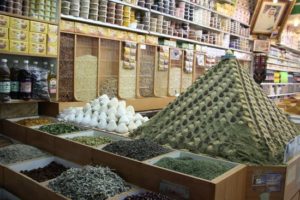
Of course, there are so many other ways of adding great salt-free flavour to your recipes.
And if you have any suggestions that you would like to share, please let me know.
In view of huge range of possibilities, we’ve only touched the tip of the spiceberg…
References
Suckling RJ, He FJ, Markandu ND, MacGregor GA. Dietary salt influences postprandial plasma sodium concentration and systolic blood pressure. Kidney Int. 2012;81( 4): 407– 11. 34.
He FJ, Li J, MacGregor GA. Effect of longer term modest salt reduction on blood pressure: Cochrane systematic review and meta-analysis of randomised trials. BMJ. 2013;346: f1325. 35.
Celermajer DS, Neal B. Excessive sodium intake and cardiovascular disease: a-salting our vessels. J Am Coll Cardiol. 2013;61( 3): 344– 5.
Oliver WJ, Cohen EL, Neel JV. Blood pressure, sodium intake, and sodium related hormones in the Yanomamo Indians, a “no-salt” culture. Circulation. 1975 Jul;52(1):146-51.
Mancilha-Carvalho J de J, de Souza e Silva NA. The Yanomami Indians in the INTERSALT Study. Arq Bras Cardiol. 2003;80( 3): 289– 300. 38.
Mancilha-Carvalho J de J, Crews DE. Lipid profiles of Yanomamo Indians of Brazil. Prev Med. 1990;19( 1): 66– 75.
Greger, Michael; Stone, Gene. How Not To Die: Discover the foods scientifically proven to prevent and reverse disease. (Air Side Edt). Pan Macmillan. Kindle Edition.
It’s The Food! Advice from John & Mary McDougall